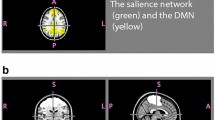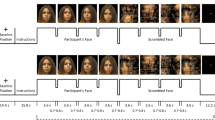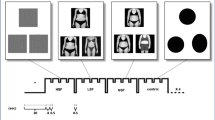Abstract
Gender dysphoria (GD) is characterized by incongruence between one’s identity and gender assigned at birth. The biological mechanisms of GD are unclear. We investigated brain network connectivity patterns involved in own body perception in the context of self in GD. Twenty-seven female-to-male (FtM) individuals with GD, 27 male controls, and 27 female controls underwent resting state fMRI. We compared functional connections within intrinsic connectivity networks involved in self-referential processes and own body perception –default mode network (DMN) and salience network – and visual networks, using independent components analyses. Behavioral correlates of network connectivity were also tested using self-perception ratings while viewing own body images morphed to their sex assigned at birth, and to the sex of their gender identity. FtM exhibited decreased connectivity of anterior and posterior cingulate and precuneus within the DMN compared with controls. In FtM, higher “self” ratings for bodies morphed towards the sex of their gender identity were associated with greater connectivity of the anterior cingulate within the DMN, during long viewing times. In controls, higher ratings for bodies morphed towards their gender assigned at birth were associated with right insula connectivity within the salience network, during short viewing times. Within visual networks FtM showed weaker connectivity in occipital and temporal regions. Results suggest disconnectivity within networks involved in own body perception in the context of self in GD. Moreover, perception of bodies in relation to self may be reflective rather than reflexive, as a function of mesial prefrontal processes. These may represent neurobiological correlates to the subjective disconnection between perception of body and self-identification.




Similar content being viewed by others
References
American Psychiatric Association (2013). Diagnostic and statistical manual of mental disorders: DSM-5 ( (5th ed.) ed.). Washington, DC: American Psychiatric Association.
Bandini, E., Fisher, A. D., Castellini, G., Lo Sauro, C., Lelli, L., Meriggiola, M. C., et al. (2013). Gender identity disorder and eating disorders: similarities and differences in terms of body uneasiness. The Journal of Sexual Medicine, 10(4), 1012–1023. doi:10.1111/jsm.12062.
Beckmann, C. F., & Smith, S. M. (2004). Probabilistic independent component analysis for functional magnetic resonance imaging. [Evaluation Studies Research Support, Non-U.S. Gov’t Validation Studies]. IEEE Transactions on Medical Imaging, 23(2), 137–152. doi:10.1109/TMI.2003.822821.
Beckmann, C. F., DeLuca, M., Devlin, J. T., & Smith, S. M. (2005). Investigations into resting-state connectivity using independent component analysis. Philosophical Transactions of the Royal Society of London. Series B, Biological Sciences, 360(1457), 1001–1013. doi:10.1098/rstb.2005.1634.
Biswal, B., Yetkin, F. Z., Haughton, V. M., & Hyde, J. S. (1995). Functional connectivity in the motor cortex of resting human brain using echo-planar MRI. Magnetic Resonance in Medicine, 34(4), 537–541.
Blanke, O., Landis, T., Spinelli, L., & Seeck, M. (2004). Out-of-body experience and autoscopy of neurological origin. Brain, 127(Pt 2), 243–258. doi:10.1093/brain/awh040.
Calhoun, V. D., Adali, T., McGinty, V. B., Pekar, J. J., Watson, T. D., & Pearlson, G. D. (2001). fMRI activation in a visual-perception task: network of areas detected using the general linear model and independent components analysis. [Research Support, Non-U.S. Gov’t Research Support, U.S. Gov’t, P.H.S.]. NeuroImage, 14(5), 1080–1088. doi:10.1006/nimg.2001.0921.
Carhart-Harris, R. L., & Friston, K. J. (2010). The default-mode, ego-functions and free-energy: a neurobiological account of Freudian ideas. [Research Support, Non-U.S. Gov’t Review]. Brain : A Journal of Neurology, 133(Pt 4), 1265–1283. doi:10.1093/brain/awq010.
Cash, T. F., & Pruzinsky, T. (2002). Body Image: A Handbook of Theory, Research, and Clinical Practice. New York: Guilford Press.
Christoff, K., Gordon, A. M., Smallwood, J., Smith, R., & Schooler, J. W. (2009). Experience sampling during fMRI reveals default network and executive system contributions to mind wandering. Proceedings of the National Academy of Sciences, 106(21), 8719–8724. doi:10.1073/pnas.0900234106.
Cohen-Kettenis, P. T., & Pfafflin, F. (2010). The DSM diagnostic criteria for gender identity disorder in adolescents and adults. Archives of Sexual Behavior, 39(2), 499–513. doi:10.1007/s10508-009-9562-y.
Cole, M. W., Bassett, D. S., Power, J. D., Braver, T. S., & Petersen, S. E. (2014). Intrinsic and task-evoked network architectures of the human brain. Neuron,, 83(1), 238–251. doi:10.1016/j.neuron.2014.05.014.
Coleman, E., Bockting, W., Botzer, M., Cohen-Kettenis, P., DeCuypere, G., Feldman, J., et al. (2012). Standards of Care for the Health of Transsexual, Transgender, and Gender-Nonconforming People, Version 7. International Journal of Transgenderism, 13(4), 165–232. doi:10.1080/15532739.2011.700873.
Craig, A. D. (2002). How do you feel? Interoception: the sense of the physiological condition of the body. Nature Reviews. Neuroscience, 3(8), 655–666. doi:10.1038/nrn894.
de Vries, A. L. C., Noens, I. L. J., Cohen-Kettenis, P. T., van Berckelaer-Onnes, I. A., & Doreleijers, T. A. (2010). Autism Spectrum disorders in gender Dysphoric children and adolescents. Journal of Autism and Developmental Disorders, 40(8), 930–936. doi:10.1007/S10803-010-0935-9.
Devinsky, O., Feldmann, E., Burrowes, K., & Bromfield, E. (1989). Autoscopic phenomena with seizures. [Case Reports Review]. Archives of Neurology, 46(10), 1080–1088.
Devue, C., & Bredart, S. (2011). The neural correlates of visual self-recognition. Consciousness and Cognition, 20(1), 40–51. doi:10.1016/j.concog.2010.09.007.
Devue, C., Collette, F., Balteau, E., Degueldre, C., Luxen, A., Maquet, P., et al. (2007). Here I am: the cortical correlates of visual self-recognition. Brain Research, 1143, 169–182. doi:10.1016/j.brainres.2007.01.055.
Downing, P. E., & Peelen, M. V. (2011). The role of occipitotemporal body-selective regions in person perception. Cognitive Neuroscience, 2(3–4), 186–203, doi:10.1080/17588928.2011.582945.
Downing, P. E., Wiggett, A. J., & Peelen, M. V. (2007). Functional magnetic resonance imaging investigation of overlapping lateral occipitotemporal activations using multi-voxel pattern analysis. [Comparative Study Research Support, Non-U.S. Gov’t]. The Journal of Neuroscience : The Official Journal Of The Society For Neuroscience,, 27(1), 226–233. doi:10.1523/JNEUROSCI.3619-06.2007.
Feusner, J. D., Dervisic, J., Kosidou, K., Dhejne, C., Bookheimer, S., & Savic, I. (2016). Female-to-male transsexual individuals demonstrate different own body identification. Archives of Sexual Behavior, 45(3), 525–536. doi:10.1007/s10508-015-0596-z.
Fox, M. D., Snyder, A. Z., Vincent, J. L., Corbetta, M., Van Essen, D. C., & Raichle, M. E. (2005). The human brain is intrinsically organized into dynamic, anticorrelated functional networks. Proceedings of the National Academy of Sciences of the United States of America, 102(27), 9673–9678. doi:10.1073/Pnas.0504136102.
Gardner, R. M., & Brown, D. L. (2014). Body size estimation in anorexia nervosa: a brief review of findings from 2003 through 2013. Psychiatry Research, 219(3), 407–410. doi:10.1016/j.psychres.2014.06.029.
Gillihan, S. J., & Farah, M. J. (2005). Is self special? A critical review of evidence from experimental psychology and cognitive neuroscience. Psychological Bulletin, 131(1), 76–97. doi:10.1037/0033-2909.131.1.76.
Greicius, M. D., Krasnow, B., Reiss, A. L., & Menon, V. (2003a). Functional connectivity in the resting brain: a network analysis of the default mode hypothesis. Proceedings of the National Academy of Sciences of the United States of America, 100(1), 253–258. doi:10.1073/Pnas.0135058100.
Greicius, M. D., Krasnow, B., Reiss, A. L., & Menon, V. (2003b). Functional connectivity in the resting brain: a network analysis of the default mode hypothesis. [Research Support, Non-U.S. Gov’t Research Support, U.S. Gov’t, P.H.S.]
Hahn, A., Kranz, G. S., Kublbock, M., Kaufmann, U., Ganger, S., Hummer, A., et al. (2015). Structural connectivity networks of transgender people. Cerebral Cortex, 25(10), 3527–3534. doi:10.1093/cercor/bhu194.
Henderson, J. M. (2007). Regarding Scenes. Current Directions in Psychological Science, 16(4), 219–222. doi:10.1111/j.1467-8721.2007.00507.x.
Heydrich, L., Lopez, C., Seeck, M., & Blanke, O. (2011). Partial and full own-body illusions of epileptic origin in a child with right temporoparietal epilepsy. Epilepsy & Behavior, 20(3), 583–586. doi:10.1016/j.yebeh.2011.01.008.
Hodzic, A., Muckli, L., Singer, W., & Stirn, A. (2009). Cortical responses to self and others. Human Brain Mapping, 30(3), 951–962. doi:10.1002/hbm.20558.
Hyvarinen, A. (1999). Fast and robust fixed-point algorithms for independent component analysis. IEEE Transactions on Neural Networks / A Publication Of The Ieee Neural Networks Council, 10(3), 626–634. doi:10.1109/72.761722.
Kelly, R. E., Alexopoulos, G. S., Wang, Z., Gunning, F. M., Murphy, C. F., Morimoto, S. S., et al. (2010). Visual inspection of independent components: defining a procedure for artifact removal from fMRI data. Journal of Neuroscience Methods, 189(2), 233–245. doi:10.1016/j.jneumeth.2010.03.028.
Kim, D. I., Manoach, D. S., Mathalon, D. H., Turner, J. A., Mannell, M., Brown, G. G., et al. (2009). Dysregulation of working memory and default-mode networks in schizophrenia using independent component analysis, an fBIRN and MCIC study. [Research Support, N.I.H., Extramural Research Support, U.S. Gov’t, Non-P.H.S.]. Human Brain Mapping, 30(11), 3795–3811. doi:10.1002/hbm.20807.
Kim, K. R., Ku, J., Lee, J.-H., Lee, H., & Jung, Y.-C. (2012). Functional and effective connectivity of anterior insula in anorexia nervosa and bulimia nervosa. Neuroscience Letters, 521(2), 152–157. doi:10.1016/j.neulet.2012.05.075.
Kranz, G. S., Hahn, A., Kaufmann, U., Kublbock, M., Hummer, A., Ganger, S., et al. (2014). White matter microstructure in transsexuals and controls investigated by diffusion tensor imaging. The Journal of Neuroscience, 34(46), 15466–15475. doi:10.1523/JNEUROSCI.2488-14.2014.
Lin, C. S., Ku, H. L., Chao, H. T., Tu, P. C., Li, C. T., Cheng, C. M., et al. (2014). Neural network of body representation differs between transsexuals and cissexuals. PloS One, 9(1), e85914. doi:10.1371/journal.pone.0085914.
Malinen, S., Hlushchuk, Y., & Hari, R. (2007). Towards natural stimulation in fMRI--issues of data analysis. [Research Support, Non-U.S. Gov’t]. NeuroImage, 35(1), 131–139. doi:10.1016/j.neuroimage.2006.11.015.
Manzouri, A., Kosidou, K., & Savic, I. (2015). Anatomical and functional findings in female-to-male transsexuals: testing a new hypothesis. Cerebral Cortex. doi:10.1093/cercor/bhv278.
Mason, M. F., Norton, M. I., Van Horn, J. D., Wegner, D. M., Grafton, S. T., & Macrae, C. N. (2007). Wandering Minds: The Default Network and Stimulus-Independent Thought. Science (New York, N.Y.), 315(5810), 393–395. doi:10.1126/science.1131295.
McKeown, M. J., Jung, T. P., Makeig, S., Brown, G., Kindermann, S. S., Lee, T. W., et al. (1998). Spatially independent activity patterns in functional MRI data during the stroop color-naming task. [Research Support, Non-U.S. Gov’t Research Support, U.S. Gov’t, Non-P.H.S.]. Proceedings of the National Academy of Sciences of the United States of America, 95(3), 803–810.
Molnar-Szakacs, I., & Arzy, S. (2009). Searching for an integrated self-representation. Communicative & Integrative Biology, 2(4), 365–367.
Molnar-Szakacs, I., & Uddin, L. Q. (2013). Self-processing and the default mode network: interactions with the mirror neuron system. Frontiers in Human Neuroscience, 7, 571. doi:10.3389/fnhum.2013.00571.
Moseley, G. L., Gallace, A., & Spence, C. (2012). Bodily illusions in health and disease: physiological and clinical perspectives and the concept of a cortical ‘body matrix’. Neuroscience and Biobehavioral Reviews, 36(1), 34–46, doi:10.1016/j.neubiorev.2011.03.013.
Northoff, G., & Panksepp, J. (2008). The trans-species concept of self and the subcortical-cortical midline system. Trends in Cognitive Sciences, 12(7), 259–264. doi:10.1016/j.tics.2008.04.007.
Northoff, G., Heinzel, A., de Greck, M., Bermpohl, F., Dobrowolny, H., & Panksepp, J. (2006). Self-referential processing in our brain--a meta-analysis of imaging studies on the self. NeuroImage, 31(1), 440–457. doi:10.1016/j.neuroimage.2005.12.002.
Peelen, M. V., & Downing, P. E. (2007). The neural basis of visual body perception. Nature Reviews Neuroscience, 8(8), 636–648. doi:10.1038/nrn2195.
Power, J. D., Barnes, K. A., Snyder, A. Z., Schlaggar, B. L., & Petersen, S. E. (2012). Spurious but systematic correlations in functional connectivity MRI networks arise from subject motion. NeuroImage, 59(3), 2142–2154. doi:10.1016/J.Neuroimage.2011.10.018.
Raichle, M. E., MacLeod, A. M., Snyder, A. Z., Powers, W. J., Gusnard, D. A., & Shulman, G. L. (2001). A default mode of brain function. Proceedings of the National Academy of Sciences, 98(2), 676–682. doi:10.1073/pnas.98.2.676.
Salomon, R., Levy, D. R., & Malach, R. (2014). Deconstructing the default: cortical subdivision of the default mode/intrinsic system during self-related processing. Human Brain Mapping, 35(4), 1491–1502. doi:10.1002/hbm.22268.
Savic, I. (2013). Structural changes of the brain in relation to occupational stress. Cerebral Cortex. doi:10.1093/cercor/bht348.
Savic, I., & Arver, S. (2011). Sex dimorphism of the brain in male-to-female transsexuals. Cerebral Cortex, 21(11), 2525–2533. doi:10.1093/Cercor/Bhr032.
Savic, I., & Lindstrom, P. (2008). PET and MRI show differences in cerebral asymmetry and functional connectivity between homo- and heterosexual subjects. Proceedings of the National Academy of Sciences of the United States of America, 105(27), 9403–9408. doi:10.1073/pnas.0801566105.
Seeley, W. W., Menon, V., Schatzberg, A. F., Keller, J., Glover, G. H., Kenna, H., et al. (2007). Dissociable intrinsic connectivity networks for salience processing and executive control. The Journal of Neuroscience, 27(9), 2349–2356. doi:10.1523/JNEUROSCI.5587-06.2007.
Sheehan, D. V., Lecrubier, Y., Sheehan, K. H., Amorim, P., Janavs, J., Weiller, E., et al. (1998). The Mini-International Neuropsychiatric Interview (M.I.N.I.): The development and validation of a structured diagnostic psychiatric interview for DSM-IV and ICD-10. The Journal of Clinical Psychiatry, 59 Suppl 20, 22–33;quiz 34–57.
Shirer, W. R., Ryali, S., Rykhlevskaia, E., Menon, V., & Greicius, M. D. (2012). Decoding subject-driven cognitive states with whole-brain connectivity patterns. [Research Support, N.I.H., Extramural Research Support, Non-U.S. Gov’t]. Cerebral Cortex, 22(1), 158–165. doi:10.1093/cercor/bhr099.
Shott, M. E., Pryor, T. L., Yang, T. T., & Frank, G. K. (2016). Greater insula white matter fiber connectivity in women recovered from anorexia nervosa. Neuropsychopharmacology : Official Publication Of The American College of Neuropsychopharmacology, 41(2), 498–507. doi:10.1038/npp.2015.172.
Swaab, D. F. (2004). Sexual differentiation of the human brain: relevance for gender identity, transsexualism and sexual orientation. Gynecological Endocrinology, 19(6), 301–312.
Tie, Y., Whalen, S., Suarez, R. O., & Golby, A. J. (2008). Group independent component analysis of language fMRI from word generation tasks. [Research Support, N.I.H., Extramural Research Support, Non-U.S. Gov’t]. NeuroImage, 42(3), 1214–1225. doi:10.1016/j.neuroimage.2008.05.028.
Uddin, L. Q. (2015). Salience processing and insular cortical function and dysfunction. Nature Reviews. Neuroscience, 16(1), 55–61. doi:10.1038/nrn3857.
Uddin, L. Q., Iacoboni, M., Lange, C., & Keenan, J. P. (2007). The self and social cognition: the role of cortical midline structures and mirror neurons. [Research Support, N.I.H., Extramural Research Support, U.S. Gov’t, Non-P.H.S. Review]. Trends in Cognitive Sciences, 11(4), 153–157. doi:10.1016/j.tics.2007.01.001.
Verosky, S. C., & Todorov, A. (2010). Differential neural responses to faces physically similar to the self as a function of their valence. NeuroImage, 49(2), 1690–1698. doi:10.1016/j.neuroimage.2009.10.017.
Vocks, S., Hechler, T., Rohrig, S., & Legenbauer, T. (2009). Effects of a physical exercise session on state body image: The influence of pre-experimental body dissatisfaction and concerns about weight and shape. [Randomized Controlled Trial]. Psychology & health, 24(6), 713–728, doi:10.1080/08870440801998988.
Vocks, S., Busch, M., Schulte, D., Gronermeyer, D., Herpertz, S., & Suchan, B. (2010). Effects of body image therapy on the activation of the extrastriate body area in anorexia nervosa: an fMRI study. Psychiatry Research, 183(2), 114–118. doi:10.1016/j.pscychresns.2010.05.011.
World Health Organization. (1992). The ICD-10 classification of mental and behavioural disorders: clinical descriptions and diagnostic guidelines. Geneva: World Health Organization.
Xu, J., Potenza, M. N., & Calhoun, V. D. (2013). Spatial ICA reveals functional activity hidden from traditional fMRI GLM-based analyses. [Opinion]. Frontiers in Neuroscience, 7. doi:10.3389/fnins.2013.00154.
Acknowledgments
We are extremely grateful to Amirhossein Manzouri for assistance with experiments and data processing, and Kyriaki Kosidou for several patient referrals. We would like to also thank Wei Li for his assistance with programming the stimuli for presentation, Marius Zimmermann for some fMRI analyses, and Gerhard Hellemann for statistical consultation.
Author information
Authors and Affiliations
Corresponding author
Ethics declarations
Financial support
This work was supported by grants from the Swedish Science Council (I.S., grant number Dnr 2007–3107); Stockholm Brain Institute (I.S.); FORTE (I.S.); AFA (I.S.); and the National Institutes of Health (J.F., grant numbers K23MH079212 and R01MH093535).
Funding
This study was funded by grants from the Swedish Science Council (I.S., grant number Dnr 2007–3107); Stockholm Brain Institute (I.S.); FORTE (I.S.); AFA (I.S.); and the National Institutes of Health (J.F., grant numbers K23MH079212 and R01MH093535).
Conflict of interest
Jamie Feusner declares that he has no conflict of interest. Andreas Lidström declares that he has no conflict of interest. Teena Moody declares that she has no conflict of interest. Cecilia Dhejne declares that she has no conflict of interest. Susan Bookheimer declares that she has no conflict of interest. Ivanka Savic declares that she has no conflict of interest.
Ethical approval
All procedures performed in studies involving human participants were in accordance with the ethical standards of the institutional research committee and with the 1964 Helsinki declaration and its later amendments or comparable ethical standards.
Informed consent
Informed consent was obtained from all individual participants included in the study.
Rights and permissions
About this article
Cite this article
Feusner, J.D., Lidström, A., Moody, T.D. et al. Intrinsic network connectivity and own body perception in gender dysphoria. Brain Imaging and Behavior 11, 964–976 (2017). https://doi.org/10.1007/s11682-016-9578-6
Published:
Issue Date:
DOI: https://doi.org/10.1007/s11682-016-9578-6




